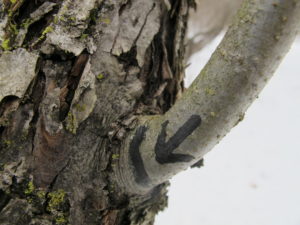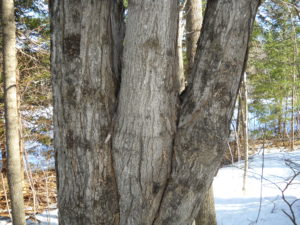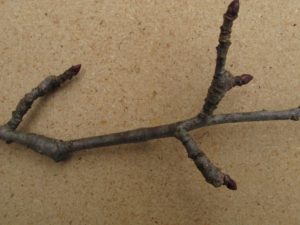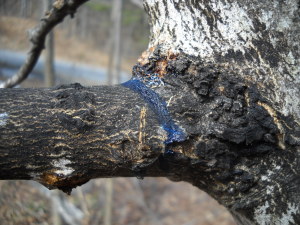8 Steps for Pruning Trees to Perfection
I find it amusing that fruit tree pruning and income tax preparations should take place at about the same time of year, and that many gardeners put off each until the last moment. You might want to start pruning now, instead of trying to do it while adding up your gasoline expenditures and medical expenses.
Below are 8 steps involved in properly pruning a tree. All are designed to create a healthier, more productive tree. By removing clutter you will allow direct sunshine to get to every leaf and wind to circulate, reducing chances of fungal infections. Keep in mind, too, that you can sculpt your tree, too, creating a thing of beauty. For me, that’s an important part of pruning.
- Remove all dead wood. You can tell if a branch is alive, even without leaves, by scratching it with a fingernail. Live twigs will show green when the outer layer of bark is removed. Dead branches will have dry, unhealthy look.
- Remove any diseased or damaged branches. Cracked branches should be removed, though I have had some grow back together by wrapping them tightly for a couple of months.
- If two branches are touching, they will rub and damage bark when the wind blows. Remove one branch.
- Branches should grow outward, away from the center of the tree. Remove any branches that aim back towards the middle of the tree.
- Branches will grow toward the light, and often two will try to fill the same space. If two are growing parallel to each other, remove one of them.
- Many fruit trees grow lots of vertical sprouts each year, each the diameter of a pencil. This is the tree’s way of producing more leaves to feed the roots, but these shoots, known as “water sprouts” will clutter up the tree. Remove most (or all) water sprouts. If you don’t do this every year, the water sprouts will become full-sized branches and your tree will a mess!
- Correct bad crotch angles. Often a branch will grow tight to the main trunk or another branch, creating a tight crotch angle. As the branch gets larger the two will grow together and bark will be swallowed up between them. This is a weak spot, and likely to split if the branches are loaded up with wet snow, or ice. Remove the offending branch – and the sooner the better. Removing a big branch is harder on the tree, and more difficult for you to do.
- Remove low branches that will interfere with mowing. If you have small children you will want them to be able to pick fruit, but you can still create room for the mower and accommodate kids.
Not all trees and shrubs should be pruned now. Spring-blooming shrubs like lilac and forsythia can be pruned, but you will lose blossoms. It’s better to prune after they bloom. Evergreens should be pruned in July after they have produced their new growth. Maples and birch should be done in early summer – right now they will “bleed” sap in large quantities.
How many branches can you take off now? Arborists say that 20% to 25% is fine. More than that, and you will start to starve the roots – leaves provide the food that roots need. That 25% figure is actually of the leaves, not the mass of wood. Dead wood doesn’t count, nor stems that support branches but have no leaves. Taking too many leaves may stimulate the tree to produce large numbers of water sprouts. That said, I once cut a huge lilac to the ground, and it came back nicely. That’s not recommended, however, and it would kill many other tree species.
Lastly, it’s important to know where to make your cuts. Branches generally have a “collar” that is at its attachment point. This collar is wider than the branch, and bark is often wrinkled. You need to cut just beyond the branch collar so that it can heal quickly and avoid infections. If you make a flush cut against the trunk, you open a wider area to diseases and insects, and remove the portion that produces protective compounds to avoid disease.
Pruning should be on your spring calendar just as garden clean-up is on your autumn calendar. But unlike clean-up, pruning get easier with time. A well-pruned tree is better behaved than one that has been ignored for 5 or 10 years. Get some good loppers, by-pass pruners and a pruning saw and get to work! And bring inside a few branches to put in a vase. They may reward you with some nice blossoms long before the outdoor trees do.
Read Henry’s blog posts at https://dailyuv.com/
Pruning Trees and Shrubs
By now you may have your garden put to bed, raked the leaves and planted spring bulbs. I haven’t, but don’t gloat if you have – there is still work to do. This is the time to prune hardwood trees and shrubs (though not evergreens, which should have been pruned back in July). Take a walk around your property and look for scruffy shrubs or trees with deadwood or crossing branches. Trees are healthier and better looking if pruned regularly, meaning at least once a year.
To me, pruning is a joy. I can’t draw a picture, but I can sculpt a tree, making a messy, un-made bed of a tree into something beautiful. If you haven’t dared to prune, give it a try. Even if you make an “oops!” cut, the tree will recover. Start slowly, never taking off more than 25% of the foliage of a tree or shrub in any given year.
Let’s start with how to prune a shrub. Walk around it 3 times, observing its growth. Is it too tall? Too wide? Is the interior of the shrub cluttered with dozens of small branches? Are there dead branches?
It is easiest to prune once the leaves have fallen so one can see the structure of the plant. My late sister, Ruth Anne, loved to start by sitting down or sprawling out underneath a shrub and looking up through it to see where clutter should be removed. Sometimes I do that too, depending on the species.
Begin by removing any dead branches. You can do that any time of the year. If the leaves have dropped and you are not certain if the branch is dead, rub it with your fingernail. If you see green when you scratch the surface, it is alive. Soon you will also notice that the bark on dead branches is a different color, and the bark is often flakey.
Next, look for branches that are rubbing against others, or branches that shoot through the middle of the shrub. Branches should go up or out, not toward the middle. Remove any that do not follow this rule.
It is important to cut branches so that you do not leave any stubs. Cut back a branch to where it originates, either on a bigger branch or to the trunk. Look for the branch “collar”. This is at the point of origin of a branch and is usually swollen and often wrinkled. Leave the branch collar as that is where the tree will heal itself. If you leave a stub past the branch collar, the stub will have to rot off – a long process – before it can heal. That could allow insects or diseases to damage the tree.
Unlike most trees, many shrubs send up multiple stems from the ground. Forsythia, mock orange and many lilacs do this, for example. If you never cut out some stems, the plant will get broader and denser in habit – and lose its graceful appearance. In general, cutting out old stems and encouraging younger growth will invigorate a shrub.
In my opinion, most trees and shrubs look best if their “legs” are exposed. That means the lower part of the stems shouldn’t have side branches and there shouldn’t be uninvited stems to shoot up from the base. Some apple trees are notorious for sending up unwanted shoots from the roots. Cut them off at the ground for a better looking tree.
Speaking of apple trees, most people think they should be pruned in March. In fact, you can prune them now, too. March is a time when farmers and orchardists had time on their hands. But you do no harm by pruning now. Many apples have lots of water sprouts, those pencil-thick stems that shoot straight up. Every year apple tree produce more, and every year I cut them off.
Deer are bad pruners. They go around trees and shrubs nibbling at twigs. Good pruners take larger branches, opening up a tree or shrub to sunlight and better air circulation with a single cut instead of 50 small ones. Taking a big cut is a bit nerve wracking at first, I suppose, but with practice it gets easier. Many trees and shrubs respond to a cut by branching and growing two or more new branches. Make 50 small cuts and you can have 100 new branches. Make a few big cuts and you get just a few new branches.
To prune well and efficiently you need good tools. Don’t go to a big box store and buy the cheapest pruners you can. Go to your garden center and buy a good pair of by-pass pruners. Felco is the most common brand of the good pruners, though I prefer pruner’s made by Bahco. Mine, the PX type, comes in 3 sizes, and left and right handed versions. I got mine from OESCO Inc. (www.oescoinc.com or 800-634-5557) in Conway, MA. I use them daily, and they seem to last forever – with only an occasional sharpening.
You’ll need a saw and some loppers, too. Don’t get a bow saw, get a nice folding saw with a tri-cut blade. And get geared loppers if you can. Fiskars makes nice ones.
So get to work. Most of us have plenty of pruning to do, and a good fall day is the perfect time to do it.
Henry’s website is www.Gardening-Guy.com. He is on vacation this week and not taking questions.






